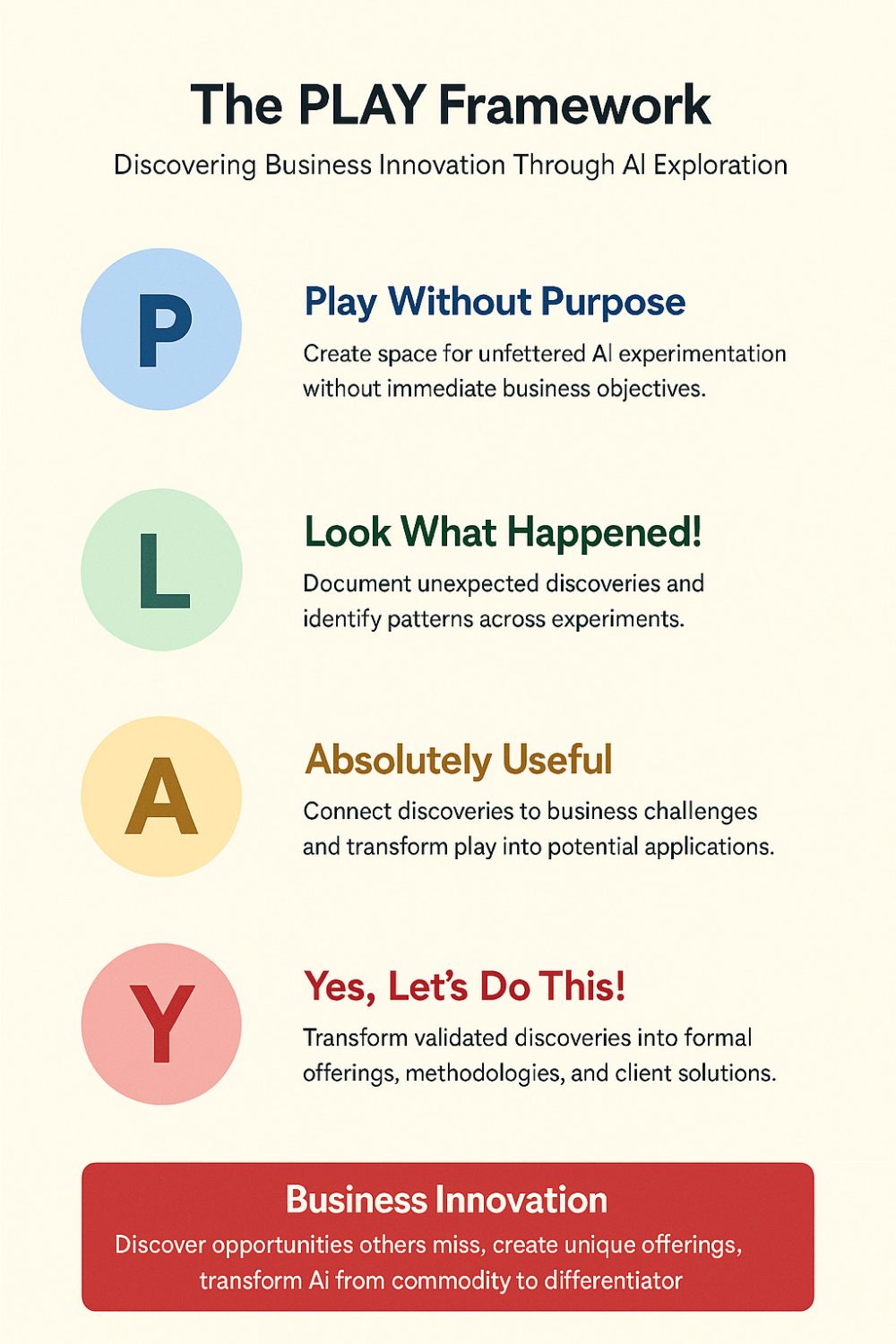 03-August-2025
03-August-2025

Over the last few days, I lost time.
It happens. Sometimes I’m in The Zone for hours at a time; I forget to eat, my wife yells at me for missing lunch, and if it weren’t for my dogs, I’d forget that “outside” even exists.
This time, what started with some simple housekeeping took me down (and up) a path that led to a complete rehaul and upgrade of my prompting practices.
Here’s what I mean by that.
I’d accumulated 79 prompts across various documents – some two sentences, others running 1,500 words. These are the backbone of my Executive Influence Engine, ranging from research prompts to the sophisticated frameworks Claude and I developed for individual and brand positioning. They lived scattered across different files, requiring the tedious dance of opening documents, copying text, switching applications, and pasting. You know the drill.
What happened next turned out to be a textbook example of my PLAY Framework in action.
For those unfamiliar, PLAY stands for Play Without Purpose, Look What Happened, Absolutely Useful, and Yes Let’s Do This. It’s a framework for discovering business innovation through AI exploration – starting with unfettered experimentation and progressing through documentation, practical application, and formal implementation.
I started with no grand vision. Just thought it would be nice to have everything organized in one place. So I used Claude to extract all the prompts, check them for consistency, and created what I thought was a beautiful, categorized library in Notion. Mission accomplished, right?
Wrong.
That’s when the real discovery emerged. As I worked with the new library, I kept thinking, “Wouldn’t it be great if I could just call these prompts from within Claude instead of all this cutting and pasting?” The friction was still there – just in a different form.
That “wouldn’t it be great if” moment is where things got interesting.
I realized this wasn’t just about my convenience. This was about changing how efficiently I could serve clients. Those longer, more specialized prompts – the ones that might feel too cumbersome to copy and paste repeatedly – could become as accessible as the simple ones. The business value became clear: faster client work and the ability to use the most sophisticated tools in my arsenal.
What followed was 12 hours of methodical trial and error that felt like play.
Now before you read on, I want you to understand that coding always scared the hell out of me and I was more than happy I’d never have to do it. I’ve gone 25+ years without creating a JavaScript file on purpose. I’ve also survived this long without ever mucking around with my system directories and I can count on one hand how many times I’ve used a Command Prompt over the past year. Two days ago, I vaguely knew what an MCP was (thank you, Chris Penn), but didn’t think I’d ever really need to know how it works.
Oh how things change.
I ditched Notion for Airtable when I realized I needed better API functionality. I built an Airtable MCP (Model Context Protocol) for Claude Desktop from scratch since no pre-built connection existed. I created a simple HTML app that turns any prompt into a one-click copy operation.
Now? I can say “Get me Prompt 25” in Claude Desktop and it pulls from my library. Even better, for complex prompts with placeholders, I can say “Get me prompt 129 and fill in all placeholders with the information in your Project Knowledge” and watch it populate.
The HTML app means I can see a prompt I want and click once – no more select-all, copy, switch applications, paste routine. Click, then Ctrl+V wherever I need it.

This is the PLAY Framework in its most practical form. What began without purpose – just wanting organized prompts – revealed friction I hadn’t acknowledged. Recognizing the business value of eliminating that friction led to building something more sophisticated than I’d originally imagined.
But here’s what makes this story relevant for anyone working in communications or leading teams through AI transformation: this wasn’t just about making my life easier. Every improvement in my workflow benefits my clients.
Speed matters when you’re helping executives navigate complex positioning challenges or supporting communications teams racing against deadlines. But depth is equally important. Those longer, more specialized prompts that used to feel too cumbersome to access repeatedly? Now they’re as easy to deploy as asking for the weather.
This means I can bring the full power of the Executive Influence Engine to every client interaction, regardless of time pressure. The 1,500-word strategic positioning prompt is now as accessible as the two-sentence research query.
The fractured landscape we’re all navigating requires this kind of systematic thinking. AI isn’t just about having tools – it’s about creating workflows that amplify your expertise rather than creating new bottlenecks.
What I’ve learned through 25 years of building communications functions is that the most powerful transformations often begin with simple frustrations. The cutting and pasting that felt like minor friction was a barrier to delivering my best work.
That’s the real magic of the PLAY Framework. It starts with curiosity – what would happen if I organized these prompts? It progresses through discovery – wait, there’s still friction here. It identifies practical value – this could transform how I work and boost productivity. And it culminates in implementation that exceeds the original vision.
For anyone building their own content creation tools or exploring AI integration in communications work, this experience offers a practical model. Start with the friction you experience daily. Let curiosity guide your initial experiments. Pay attention to what those experiments reveal about larger possibilities. Then build systems that transform those discoveries into sustainable competitive advantages.
The human in the loop isn’t just about maintaining authenticity in AI-assisted work. It’s about creating workflows where human expertise and AI capabilities amplify each other rather than compete.
What started as prompt organization became a productivity evolution. That’s the power of structured play in an AI-augmented world.
Here’s how I did it: I used my own Executive Influence Engine, built out as a Claude Project. I gave the Dan Engine the details about my adventure along with the ideas I wanted to cover, and the Engine gave me an incredible draft. I then refined the narrative flow, made adjustments as needed, and did a final edit.
The core experience and insights are mine – Claude helped me organize and articulate them.